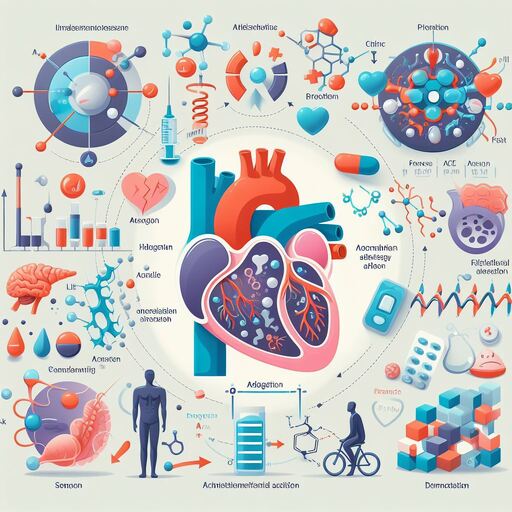Mechanism of action and side effects of ACE Inhibitors
Mechanism of action and side effects of ACE Inhibitors
Here are some common ACE inhibitors:
1. Lisinopril (Princeps): Lisinopril is an ACE inhibitor used to treat high blood pressure and congestive heart failure. It works by blocking the action of angiotensin II, a hormone that can cause blood vessels to constrict and raise blood pressure. When lisinopril is taken orally, it is absorbed into the bloodstream and travels to the kidneys and other tissues in the body where angiotensin II is produced. By blocking the action of angiotensin II, lisinopril helps reduce blood pressure and improve cardiac function.
Side effects of lisinopril can include headache, dizziness, lightheadedness, dry mouth, coughing, nausea, vomiting, diarrhea, constipation, and increased appetite. In rare cases, lisinopril can cause sudden drops in blood pressure (hypotension), which can lead to fainting or near-fainting spells. Patients taking lisinopril should be monitored closely by their healthcare provider and may need to adjust the dosage or switch to a different medication if side effects are severe or persistent.
2. Enalapril (Procardia): Enalapril is an ACE inhibitor used to treat hypertension and heart failure. It works by blocking the action of angiotensin II, which helps reduce blood pressure and improve cardiac function. When enalapril is taken orally, it is absorbed into the bloodstream and travels to the kidneys and other tissues in the body where angiotensin II is produced. By blocking the action of angiotensin II, enalapril helps reduce blood pressure and improve cardiac function.
Side effects of enalapril can include headache, dizziness, lightheadedness, dry mouth, coughing, nausea, vomiting, diarrhea, constipation, and increased appetite. In rare cases, enalapril can cause sudden drops in blood pressure (hypotension), which can lead to fainting or near-fainting spells. Patients taking enalapril should be monitored closely by their healthcare provider and may need to adjust the dosage or switch to a different medication if side effects are severe or persistent.
3. Benazepril (Lotrel): Benazepril is an ACE inhibitor used to treat high blood pressure and heart failure. It works by blocking the action of angiotensin II, which helps reduce blood pressure and improve cardiac function. When benazepril is taken orally, it is absorbed into the bloodstream and travels to the kidneys and other tissues in the body where angiotensin II is produced. By blocking the action of angiotensin II, benazepril helps reduce blood pressure and improve cardiac function.
Mechanism of action and side effects of ACE Inhibitors
Side effects of benazepril can include headache, dizziness, lightheadedness, dry mouth, coughing, nausea, vomiting, diarrhea, constipation, and increased appetite. In rare cases, benazepril can cause sudden drops in blood pressure (hypotension), which can lead to fainting or near-fainting spells. Patients taking benazepril should be monitored closely by their healthcare provider and may need to adjust the dosage or switch to a different medication if side effects are severe or persistent.
4. Ramipril (Altace): Ramipril is an ACE inhibitor used to treat hypertension and heart failure. It works by blocking the action of angiotensin II, which helps reduce blood pressure and improve cardiac function. When ramipril is taken orally, it is absorbed into the bloodstream and travels to the kidneys and other tissues in the body where angiotensin II is produced. By blocking the action of angiotensin II, ramipril helps reduce blood pressure and improve cardiac function.
Side effects of ramipril can include headache, dizziness, lightheadedness, dry mouth, coughing, nausea, vomiting, diarrhea, constipation, and increased appetite. In rare cases, ramipril can cause sudden drops in blood pressure (hypotension), which can lead to fainting or near-fainting spells. Patients taking ramipril should be monitored closely by their healthcare provider and may need to adjust the dosage or switch to a different medication if side effects are severe or persistent.
5. Furosemide (Lasix): Furosemide is a steroid diuretic that can be used in combination with ACE inhibitors to treat heart failure. It works by increasing the amount of sodium and water excreted through the kidneys, which helps reduce blood pressure and improve cardiac function. When furosemide is taken orally, it is absorbed into the bloodstream and travels to the kidneys and other tissues in the body where sodium and water are produced. By increasing the amount of sodium and water excreted, furosemide helps reduce blood pressure and improve cardiac function.
Mechanism of action and side effects of ACE Inhibitors

